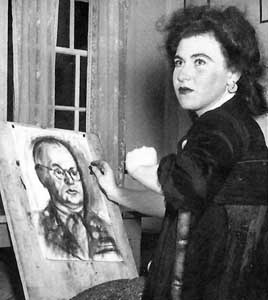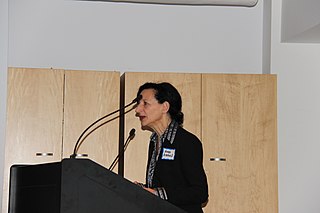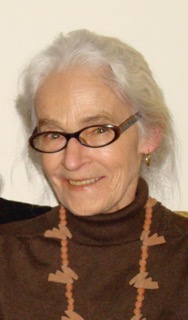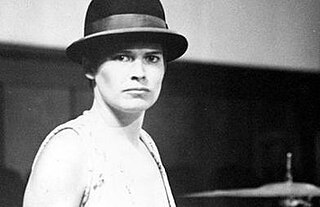Related Research Articles

Rebecca Belmore is an interdisciplinary Anishinaabekwe artist who is particularly notable for politically conscious and socially aware performance and installation work. She is Ojibwe and member of Obishikokaang. Belmore currently lives in Toronto, Ontario.

Unity Bainbridge was a Canadian artist and writer of poetry inspired by the indigenous peoples of the Pacific Northwest Coast and its landscape.

Sara Louise Diamond, is a Canadian artist and the current president of OCAD University, Canada.
Dana Claxton is a Hunkpapa Lakota filmmaker, photographer, and performance artist. Her work looks at stereotypes, historical context, and gender studies of Indigenous peoples of the Americas, specifically those of the First Nations. In 2007, she was awarded an Eiteljorg Fellowship for Native American Fine Art.

Anna Banana is a Canadian artist known for her performance art, writing, and work as a small press publisher. She has been described as an "entrepreneur and critic", and pioneered the artistamp, a postage-stamp-sized medium. She has been prominent in the mail art movement since the early 1970s, acting as a bridge between the movement's early history and its second generation. As a publisher, Banana launched Vile magazine and the "Banana Rag" newsletter; the latter became Artistamp News in 1996.
Julie Andreyev is a Vancouver-based multidisciplinary artist whose practice explores themes of animal agency and consciousness. Her ongoing Animal Lover work explores nonhuman animal agency and creativity through modes of interspecies collaboration and aleatoric methods. The Animal Lover projects seek to contribute towards an ethic of compassion and regard for the intrinsic worth of other-than-human individuals. She was born in Burnaby, British Columbia.

Audrey Capel Doray is a Canadian artist working in a variety of mediums—painting, printmaking, electronic art, murals, and films. In addition to her solo and group exhibitions, her work was exhibited at the 6th Biennial Exhibition of Canadian Painting at the National Gallery of Canada in 1965. A serigraph Diamond is held in the Tate Gallery London and the National Gallery of Canada. Her work is described in North American Women Artists of the Twentieth Century as combining "robust social criticism with her own interpretation of humanist theory" and dealing with pop art and the feminist archetype, themes of "perpetual motion and endless transition", and the interplay of sound and light.

Kate Craig was a pioneering Canadian video and performance artist. She was a founding member of the artist-run centre the Western Front, where she supported the video and performance works of many artists while producing her own body of work. She is known for her performances as 'Lady Brute' and for her video works.
Marina Roy is a visual artist, educator and writer based in Vancouver, British Columbia.
Lillian Irene Hoffar Reid was a Canadian painter. She was in the first graduating class, June 1929, at the Vancouver School of Decorative and Applied Art. She taught at the Vancouver School of Art from 1933 to 1937.
Laiwan is an interdisciplinary artist, writer, curator and educator based in Vancouver, British Columbia. Her wide-ranging practice is based in poetics and philosophy.
Tania Willard is an Indigenous Canadian multidisciplinary artist, graphic designer, and curator, known for mixing traditional Indigenous arts practices with contemporary ideas. Willard is from the Secwepemc nation, of the British Columbia interior, Canada.
VIVO Media Arts Centre, run under the Satellite Video Exchange Society, (SVES) is an artist-run centre and video distribution library located in Vancouver, Canada. It was founded in 1973 to promote the non-commercial use of video technology by providing international and educational video exchange through a public video library. Its mission has then been expanded to provide equipment rentals, artist workshops, and provide information to the public about media arts.
Jennifer Weih is a Canadian artist and educator based in Vancouver, British Columbia. She currently teaches at the Emily Carr University of Art and Design. Weih received her BFA from the Emily Carr University of Art and Design and her MFA from the University of British Columbia. She works in installation, objects, video, and print. Her projects include a range of aesthetics including found, manufactured, or crafted materials. She is part of the production team at Other Sights for Artists' Projects. Weih was a programmer for VIVO Media Arts Centre, which she initiated community oriented projects, and founded Signal and Noise Media Art Festival.
Intermedia was a Canadian artists' association active in the late 1960s and early 1970s, based in Vancouver, British Columbia.
Lorna Boschman (1955) is a Canadian Queer media artist, film maker, curator, educator, editor, and camera operator working with themes such as sexual identity, body image, social justice, (dis)ability, cancer, abuse, health, and self-advocacy.
Annie Briard is a Canadian intermedia visual artist based in Vancouver, British Columbia. Her video, photographic, and installation-based work explores the intersections of perceptual paradigms between psychology, neuroscience and existentialism, challenges the uncertain nature of perception itself, and memory.
Women in Focus (WIF) was a feminist film and video distribution centre and gallery based in Vancouver, Canada. It operated from 1974 to 1992.
Helen Goodwin was an English-born, British Columbia-based artist, dancer, teacher, and organizer who specialized in dance and choreography. Goodwin was an active member of Vancouver experimental art community in the 1960s and 1970s, organizing and performing at festivals, exhibitions and artist-run centres. She is best known for co-founding Intermedia and for forming TheCo, a dance troupe.
Denise Ryner is a Canadian curator and writer. She is director and curator at Or Gallery, Vancouver. Ryner has worked as an independent curator, writer and educator at several galleries, artist-run centers and institutions, in Toronto, Vancouver and Berlin. Ryner has contributed to publications like FUSE magazine and Canadian Art magazine.
References
- 1 2 3 4 5 6 7 Nicholson, Cecily; Mancini, Donato; Muir, Alex; Kazymerchyk, Amy; and Bradly, Sharon (2013). "Interview with Crista Dahl" in Anamnesia: Unforgetting, Polytemporality, implacement and possession in The Crista Dahl Media Library & Archive. DVD, book and website. Retrieved 23 March 2017. http://anamnesia.vivomediaarts.com/
- 1 2 3 4 5 6 7 8 9 Ferrari, Elisa; Klassen, Lois (2013). "Crista Dahl: Life Rhythm, a Retrospective". VIVO Media Arts Centre. Retrieved 23 March 2017.
- 1 2 3 4 5 6 Lowndes, Joan (11 February 1972). ""Children Learn Primitive Arts Through Teacher's Initiative"". The Vancouver Sun. pp. 8–9.
- 1 2 Wallace, Pat (11 June 1977). ""Life rhythms"". Province Lifestyles.
- 1 2 3 4 5 6 Stoller, Lincoln. "The Learning Project - Crista Dahl Interview." Mind Strength Balance. Web. Retrieved 2 April 2017. http://www.mindstrengthbalance.com/learn/interviews/cristadahl.htm
- ↑ Centennial Museum and the H R MacMillan Planetarium. "Press Release" 17 September 1971.
- ↑ "Annual Exhibition: Northwest Artists Show Work". The Seattle Times. 15 October 1964.